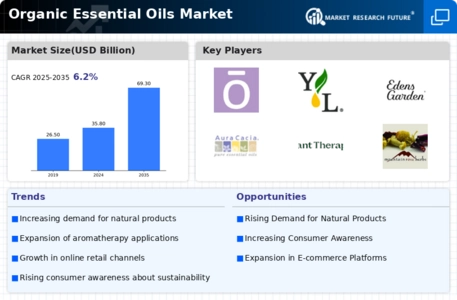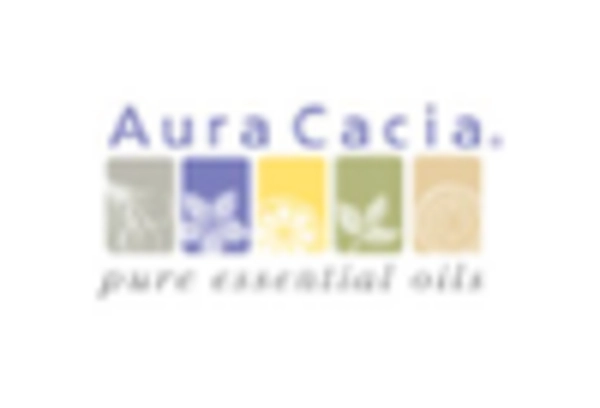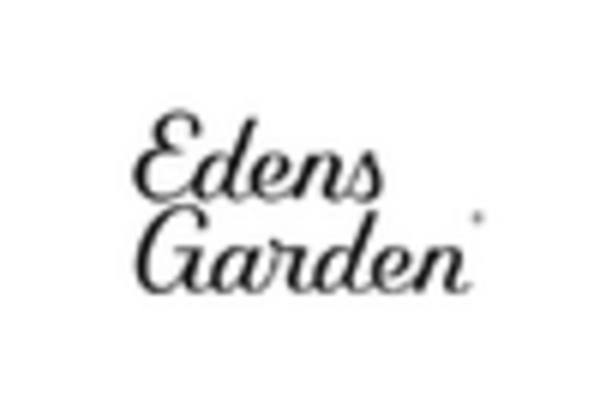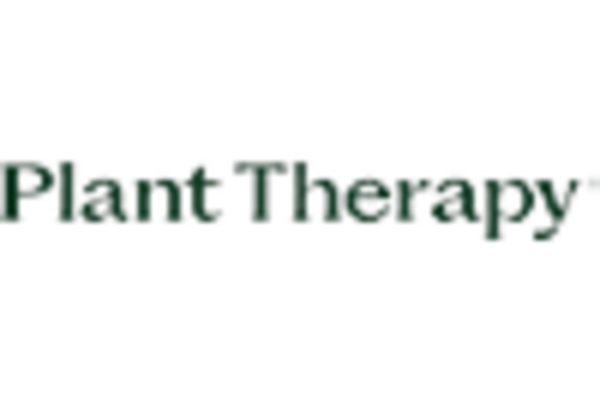Expansion of Aromatherapy Practices
The Organic Essential Oils Market is significantly influenced by the expansion of aromatherapy practices across various demographics. Aromatherapy, which utilizes essential oils for therapeutic purposes, has gained traction among consumers seeking stress relief and relaxation. The market for aromatherapy is anticipated to grow at a compound annual growth rate of over 10% in the coming years. This growth is attributed to the increasing acceptance of alternative therapies and the integration of essential oils into wellness routines. As more individuals recognize the psychological and physiological benefits of aromatherapy, the demand for organic essential oils is expected to rise. This trend not only enhances the visibility of the Organic Essential Oils Market but also encourages innovation in product offerings tailored to meet the diverse needs of consumers.
Increased Use in Food and Beverage Sector
The Organic Essential Oils Market is experiencing a notable increase in the utilization of essential oils within the food and beverage sector. As consumers become more health-conscious, there is a growing preference for natural flavoring agents over synthetic additives. Essential oils, known for their potent flavors and aromas, are being incorporated into various food products, including beverages, snacks, and health supplements. Market analysis indicates that the food and beverage segment is projected to account for a significant share of the essential oils market, with a growth rate of approximately 8% annually. This trend reflects a broader consumer shift towards clean label products, where transparency and natural ingredients are prioritized. Consequently, the Organic Essential Oils Market is likely to expand as food manufacturers increasingly adopt organic essential oils to enhance product appeal and meet consumer expectations.
Sustainability and Eco-Friendly Practices
The Organic Essential Oils Market is increasingly aligned with sustainability and eco-friendly practices, which resonate with contemporary consumer values. As environmental concerns gain prominence, consumers are more inclined to support brands that prioritize sustainable sourcing and production methods. The organic certification process ensures that essential oils are produced without harmful pesticides or chemicals, appealing to environmentally conscious consumers. Market trends suggest that the demand for sustainably sourced organic essential oils is on the rise, with consumers willing to pay a premium for products that align with their values. This shift towards sustainability not only enhances the reputation of the Organic Essential Oils Market but also encourages companies to adopt responsible practices throughout their supply chains. As a result, the industry is poised for growth as it embraces eco-friendly initiatives.
Growing Consumer Awareness of Health Benefits
The Organic Essential Oils Market is experiencing a notable surge in consumer awareness regarding the health benefits associated with organic essential oils. As individuals increasingly seek natural remedies for various ailments, the demand for these oils has escalated. Research indicates that the market for essential oils is projected to reach approximately 13 billion USD by 2026, driven by this heightened awareness. Consumers are gravitating towards organic options, perceiving them as safer and more effective alternatives to synthetic products. This trend is further fueled by the rising popularity of holistic health practices, which emphasize the use of natural ingredients. Consequently, the Organic Essential Oils Market is likely to witness sustained growth as more consumers prioritize health and wellness in their purchasing decisions.
Rising Popularity of Natural Personal Care Products
The Organic Essential Oils Market is benefiting from the rising popularity of natural personal care products. Consumers are increasingly opting for personal care items that are free from harmful chemicals, leading to a shift towards organic formulations. The personal care segment, which includes skincare, haircare, and cosmetics, is projected to witness substantial growth, with organic essential oils playing a pivotal role in product development. Market data suggests that the organic personal care market is expected to reach 25 billion USD by 2027. This trend is indicative of a broader movement towards sustainability and eco-consciousness, prompting manufacturers to incorporate organic essential oils into their formulations. As a result, the Organic Essential Oils Market is likely to thrive as brands respond to consumer demand for safer, more natural alternatives.

















Leave a Comment